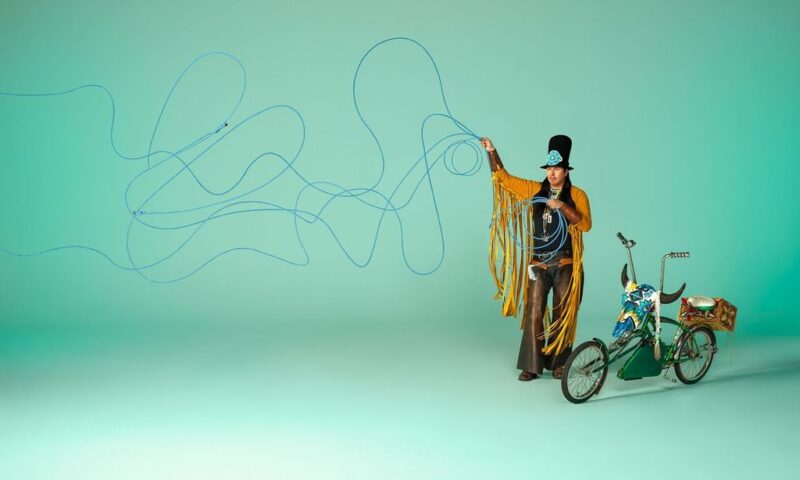ArtForum: Dan Steinhilber at the Kreeger Museum by Kriston Capps
Tucked away in a marvelous Philip Johnson–designed building in Washington, D.C.’s tony Foxhall neighborhood, the Kreeger Museum is as proud of its building as it is of its handsome, modest, modern collection. The Kreeger commissioned Dan Steinhilber to create a site-specific solo show, and so he did, but he considered the building not as a museum but rather in its context as a former home. Rummaging through the old belongings of David and Carmen Kreeger and selecting long-hidden and discarded ephemera—a loveseat, an ironing board, three horrid stuffed marlins—Steinhilber reveals a secret history of the institution. He recorded unique testimonials of everything he found—a space heater cranking up, a smoke alarm beeping its test message, a trunk being dragged here and there, and so on—in order to collect a library of noises.
New York Magazine: Jerry Saltz on Wade Guyton’s New Inkjet Paintbrush
In the early sixties, Andy Warhol invented a new paintbrush. It was Gerard Malanga, the assistant who applied and pulled pigments over Warhol’s early silk-screens. Andy, who would mutter things like “Oh, gee, that’s nice, Gerard” as he watched the young dreamboat work, was willing to be played for the fool, to be called “swish” and “faggot” by outsiders and forgo the accumulated masculine-historical authority of oil paint on canvas applied by hand, giving up all conventional ideas about touch in order to find another touch. The rest is art history.
In 2002,
Wade Guyton invented a new paintbrush. Its name was the Epson printer. The rest isn’t art history, but—as seen in the Whitney’s stylish, stately survey of Guyton’s work—his invention marks a step in painting’s evolution and flexibility. Employing Microsoft Word, desktop computers, Adobe Photoshop, bitmapped files, UltraChrome and DuraBrite inkjet on linen, book pages, exhibition invitations, and plywood, Guyton has arrived at something as powerful, albeit more subtle, yet as enticing as Dan Flavin’s fluorescent lights. It’s a technique that implies the operation of almost unknowable forces. Instead of harnessing the pulsing color currents of Flavin’s electricity, Guyton’s flawed beauty and philosophical insight let us glimpse the ghost in the machine.
http://www.vulture.com/2012/10/saltz-on-wade-guyton-os-at-the-whitney.html
Art News: Hank Willis Thomas Stages a Photo Shoot: How Sanford Biggers came to strike a pose as a two-faced dandy by Rachel Wolff
It’s not always quite this bustling, Hank Willis Thomas tells me as we make our way into his small, fifth-floor studio located in Midtown Manhattan; it’s just when he’s gearing up for a major project or a show—which, these past few years, has been more or less his perpetual state. With posters, postcards, fabric samples, and mock-ups pinned haphazardly to the walls, bicycles parked in a corner, and a handful of cluttered workstations (each anchored by an iMac or a MacBook Pro), the tightly packed space could be home to any young, energetic, creative New York start-up. And, in a sense, that’s what it is, with Thomas installed as CEO.
Challenging Work: Peter Shjeldah on Ai Weiwei at the Hirshhorn
THE ART WORLD about “Ai Weiwei: According to What?,” a retrospective at the Hirshhorn Museum in Washington, D.C., which the writer calls “spectacular.” Last year, Ai Weiwei was jailed, for three months, without charge; he has braved periods of house arrest, a beating that caused a brain hemorrhage, the demolition of his newly built studio in Shanghai, and more. Does admiring his work enlist you in his struggles? And, if you consider him a victim of oppression, should the work’s quality even matter? Ai imports to China derivative forms of American and European Pop, post-minimalism, and conceptualism. Not much about what he does is aesthetically novel. But his art works are always elegant, superbly crafted, and mightily theatrical, perhaps making up in splendor what they lack in fertility. Mentions the artist’s work in response to 2008’s Sichuan earthquake, in which thousands of children died when their school buildings collapsed.
Read more http://www.newyorker.com/arts/critics/artworld/2012/10/22/121022craw_artworld_schjeldahl#ixzz2AYXlgPGV

NY Times: The Lives of Jeffrey Deitch by Guy Trebay
ZELIG is missing. It is a crisp evening and along Santa Monica Boulevard, out toward the Paramount lot, a platoon of valet parkers stands theatrically awaiting stardom or the arrival of the city’s cultural cognoscenti, whichever comes first. The autumn arts season is under way here, and the occasion is the inaugural exhibition of the new Regen Projects gallery, a white stucco fortress so hulking and large it could easily swallow up great chunks of Chelsea. A show of work by artists both new and established has drawn out the city’s creative types along with dealers and collectors and curators, eager to see an outpost pioneered by the dealer Shaun Caley Regen in an unlikely corner of this art-absorbed city.
Art Fag City at The L Magazine: Regarding Regarding Warhol: It Sucks! by Paddy Johnson
What’s better for cocktail party conversation: a trip to the The Metropolitan Museum to see the exhibition or a trip to a couple out-of-the-way shows you might actually like? I did both recently; this week, we’ll focus on the Met—because high-profile flops are generally great for party chatter. Aside from The New Yorker’s Peter Schjeldahl, basically every critic in the city has panned Regarding Warhol. That’s for good reason. Curators Mark Rosenthal, Marla Prather, Ian Alteveer, and Rebecca Lowery have assembled a conceptually empty show around the idea that Warhol has influenced the art world’s biggest stars—especially the long list of them included in this show.
http://www.thelmagazine.com/newyork/regarding-regarding-warhol-it-sucks/Content?oid=2273124Hyperallergic: The 20 Most Powerless People in the Art World: 2012 Edition by The Editors
It’s that time of year again. Art Review just had their fun bringing the art world their directory of the rich and powerful, and now it’s our turn to flip the script and point out that not everyone is rich, famous, or powerful in our beloved community. Here is our infamous Hyperallergic Powerless 20! The art world can suck, but for these people it sucks just a little bit more.
http://hyperallergic.com/59221/powerless-20-2012-edition/

ArtInfo: The Story Behind Richard Artschwager’s Whitney Survey and High Line “blps” by Charmaine Picard
“Art can take you to funny places,” says Richard Artschwager on a rainy August afternoon in the modest one-bedroom apartment he shares with his wife, Ann. The couple, who met in 1991 while Ann was working at the Mary Boone Gallery, in New York, are in the process of downsizing. They recently sold their primary residence, a converted church in Hudson, New York, and have transformed Richard’s nearby art studio into a live-and-work space. These days they divide their time between the Hudson Valley studio and their Manhattan pied-à-terre in Chelsea’s London Terrace. The 88-year-old Artschwager remains every bit the artist of his youth—thoughtful and witty, with a scientific bent.
http://www.artinfo.com/news/story/836148/the-story-behind-richard-artschwagers-whitney-survey-and-high
Washington City Paper: Should The Corcoran Stay or Should It Go? By Kriston Capps
Should you sell your home? No homeowner would answer this question based on the cost of remodeling alone—without considering her income, savings, debt, spending, or the strength of the housing market. And yet, that’s the question that the Corcoran Gallery of Art poses for its community. It’s virtually impossible for anyone to say whether the Corcoran needs to sell its historic building at 17th Street and New York Avenue NW, because no one knows how bad the bleeding is at Washington’s oldest museum. The Corcoran has talked up the millions it would cost to bring its building up to modern museum standards—a long-term proposition. Meanwhile, it has been selling property, like a lease on land nearby sold recently to Carr Properties, in order to cover day-to-day operating expenses. While the board is struggling to keep the lights on, the Corcoran is simultaneously sussing out what value the building might have to a potential buyer, as well as what value the museum and college might have to another organization or municipality in the Washington area. Most of these variables are question marks.
http://www.washingtoncitypaper.com/articles/43393/should-the-corcoran-stay-or-should-it-go/

New York Times: Rethinking the Armory Show: Recent scholarship has led to re-examination of the 1913 show of modern art that was held at the 69th Regiment Armory in New York. by Holland Cotter
In 1913 — a few months short of a century ago — you are in New York City, not yet the world cultural capital. It’s a seething, manic place, with a powerful but provincial population. Wall Street is challenging London’s dominance of the international stock market, and finishing touches are being put on the highest high-rise on the planet, the Woolworth Building, in Lower Manhattan. But beneath the cheers and the whir of machines, there is another sound: shouting, as 10,000 women demanding the vote march down Fifth Avenue, and a mass protest by striking mill workers fills Madison Square Garden to the explosion point.
At one time, a New Yorker rattled by noise and change could seek solace in art, in the visual smoothness and moral sureties of, say, Gilded Age painting, with its lush landscapes, classical tableaus and teatime interiors. Now, suddenly, that option was being all but closed.













